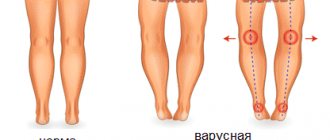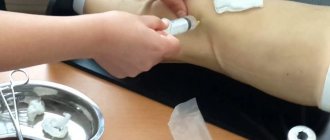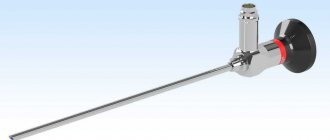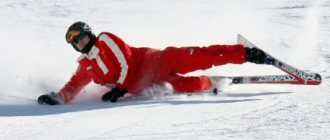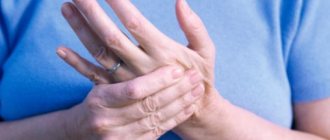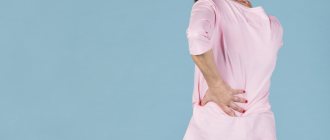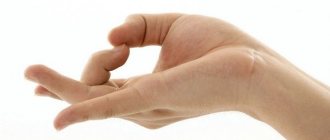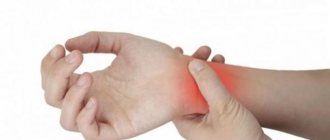Bouchard's and Heberden's nodes are a problem for many elderly and young people. Knodularity in the fingers hinders movement, causes severe pain and is visually unsightly. The appearance of such formations can be stimulated by many factors, and their treatment is a complex and multi-stage procedure.
What are Heberden's and Bouchard's nodes
Bouchard's and Heberden's nodes are identical in structure, but differ in location. The first are located on the joints of the extreme phalanges of the fingers, the second on the middle phalanges.
Damage to the joints of the thumbs is called rhizarthrosis.
They represent deforming nodular arthrosis of the hands, in which the amount of synovial fluid in small cartilages decreases and the elasticity of the joints is lost. Due to the friction of the articular surfaces against each other, injuries occur, followed by aseptic inflammation and the release of a pathological fluid substance. The latter bursts the joint capsule and deforms it. This is how a knot is formed.
Why and how the disease develops
This manifestation of deforming arthrosis of the hand occurs, as a rule, in older women due to hormonal changes during menopause. In men, accordingly, it happens much less often.
Clear reasons for the etiopathogenesis of this pathology have not yet been identified, but some studies indicate the role of heredity - clinical manifestations in the form of Heberden’s and Bouchard’s nodes occur in relatives of different generations. That is, the tendency to metabolic disorders and anatomical features of the structure of small joints is transmitted through certain genes, and under the influence of provoking factors (age-related changes, hormonal changes), deforming arthrosis develops. Also, the formation of Heberden's and Bouchard's nodes can occur on the fingers of patients with diabetes mellitus and pathologies of the endocrine system.
A number of provoking factors have been identified that contribute to the occurrence of multiple deforming lesions of small joints of the hands:
- heredity;
- menopause;
- congenital structural features;
- increased activity of lysosomal enzymes;
- diabetes;
- pathologies of the thyroid gland;
- overweight;
- traumatic joint injuries.
There is evidence that the disease can develop in people of certain professions associated with stress on their hands - programmers, dentists, athletes, teachers and others. They are more likely to have rhizarthrosis - damage to the joints of the thumbs.
Degenerative-dystrophic processes in the tissues of the cartilage of small joints of the hands lead to a decrease in the production of natural lubrication, which leads to cartilage dysfunction due to their loss of elasticity. Friction of the affected articular surfaces causes injury, aseptic inflammation develops with accompanying symptoms, in particular, the release of pathological joint fluid that bursts the joint capsules, which causes their deformation and pain in the hands.
Causes of the disease
So far, doctors have not identified any clear reasons for the development of pathology. However, studies have been conducted on this topic, which have shown that the appearance of Heberden's nodes can be caused by a hereditary factor. Pathology in some cases manifests itself both in the next generation and after several. Thus, the features of the anatomical development of articular joints can be transmitted through genes.
The mechanism of pathological changes in the form of deforming arthrosis can be triggered due to:
- Hormonal imbalance;
- Age-related changes;
- Diabetes mellitus;
- Transmission of viral diseases;
- Excess body weight;
- Increased activity of enzyme substances synthesized in lysosomes;
- Congenital articular and bone anomalies;
- Thyroid pathologies;
- Injuries to bones and finger joints.
Female representatives over 50 years of age are most susceptible to the appearance of knots on the fingers. This is due to age-related hormonal changes.
Another reason for the appearance of knots can be hard work and constant hypothermia of the hands. Bouchard's and Heberden's nodes appear in workers who work with rotary hammers, drills, hammers, those engaged in difficult non-mechanized work, and in women who often wash in ice holes and cold water. Athletes who play tennis, volleyball and basketball are also at risk.
Causes of formation of Bouchard's nodes
Heberden's and Bouchard's nodes are characteristic of osteoarthritis, or more precisely, of its special form - nodular arthrosis. They arise exclusively against the background of this disease, and never on their own. It is believed that genetic factors play a role in the formation of nodules - the form of osteoarthritis in which they appear is transmitted through the female line and is more common in women. The incidence ratio in men and women is 1:10.
Heberden nodes on the fingers are formed against the background of osteoarthritis.
The formation of knot-like bone formations is the body's response to the degradation of articular cartilage. Normally, synovial cartilage protects the heads of bones, preventing them from rubbing against each other, and also softening impacts. When cartilage dries, cracks, or wears out, its properties deteriorate, and the bones begin to rub against each other instead of sliding smoothly as before. To compensate for injuries and limit movement in the diseased joint, the bone begins to grow osteophytes.
Bouchard's nodes also appear due to factors such as:
- Age
. Hormonal changes during menopause and postmenopause affect the quality of cartilage and bone tissue. Therefore, the appearance of the first nodes is observed at the age of 45 years and older. After 80 years, they occur in every third person. At a young age, Heberden's nodes can form in professional baseball players, tennis players, and turners. - Heredity
. Several disorders of collagen synthesis, not yet well understood, affect the likelihood and rate of nodule formation. Also, Bouchard's nodules are 3.5 times more likely to occur in people whose relatives have similar symptoms. - Injuries
. Working with vibrating tools, household and sports injuries, and cold injuries negatively affect the condition of the cartilage and can provoke the development of osteoarthritis and, as a consequence, the occurrence of Bouchard's nodules. - Anomalies in the structure of the hand
, which affect the consistency of the articular surfaces and the specifics of movement in the joint. They can be congenital (eg, joint hypermobility) or acquired (eg, malunion of fractures). - Diseases
related to metabolism - for example, diabetes, gout, immune disorders - rheumatoid arthritis, or hormonal problems - hypothyroidism and others.
The causes and treatment of Heberden's nodes are always associated with the underlying disease - osteoarthritis of the fingers.
Clinical picture and stages of development
Symptoms of Bouchard's and Heberden's nodes vary depending on the stage of development of the pathology. There are three different stages of the disease.
Signs of the first stage:
- Periodic pain that appears when working or moving your fingers;
- Swelling in the phalangeal areas.
During the second stage, the following symptoms appear:
- The pain becomes more stable and becomes aching;
- The skin over the phalanges turns red and swells;
- The muscles in the fingers begin to atrophy;
- Movements in the hand and fingers are limited and all of them are accompanied by crunching;
- Nodular growths begin to appear on the phalanges (they remain even when swelling and redness disappear).
The final third stage is characterized as follows:
- Swelling and redness of the skin over the phalanges does not go away;
- The deformation of the joints becomes very noticeable;
- It becomes almost impossible to bend your fingers or hand;
- All parts of the hand are curved;
- The affected hand becomes thinner.
At the last stage, the pain becomes very severe. It’s as if my hands are twisting and few ointments help relieve the symptoms.
Symptoms
In 30% of cases, Heberden's nodes with damage to the joints of the hands can form without severe symptoms. The pathology first affects the back of the nail phalanges of the index and middle fingers. It is characteristic that the deformation develops symmetrically, simultaneously. Their size can range from a grain of rice to a large pea.
Symptoms develop as follows:
- Heberden's nodules appear with the formation of swelling and hyperemia of the skin at the site of inflammation. The patient feels pain and a burning sensation in the joints.
- The disease is chronic, with periodic exacerbations, characterized by severe throbbing pain and the formation of a fluid-filled blister on the skin. After opening the vesicle on your own, the pain decreases.
- If the blisters on the skin do not open, the acute period lasts for several weeks, sometimes for several months. Over time, pain decreases, swelling and hyperemia of the skin disappear. The resulting Heberden and Bouchard nodes are dense and painless.
- As it progresses, the joints gradually become deformed and their mobility is limited. You can see what such a hand looks like in the photo. Periodically, the disease worsens.
Bouchard's nodules form slowly, without a bright clinic.
- Bouchard's nodules are located on the joints near the palm, on the lateral articular surfaces.
- Fingers become like a spindle.
- Over time, the joints become stiff, although they do not cause pain.
This pathology does not affect the patient’s internal organs and systems, but pain in the acute period and limited mobility of the fingers with their deformation greatly affect the quality of life. If left untreated, it can lead to complete loss of movement in the hands.
In the case of the development of rhizatrosis, when a deformity of the thumb develops, the disease may begin with soreness and crunching at the base of the palm.
When symptoms of pain, swelling and redness of the thumb appear, incipient multiple arthrosis should be differentiated from gout and psoriatic lesions.
Methods of treating the disease
Treatment of deforming arthrosis must be comprehensive. Therapeutic measures have two vectors of focus:
- Stimulating the circulation of blood and other biological fluids in the joint cavities;
- Restoration of cartilage tissue (if this can still be done).
Therapy of joint diseases is a long and labor-intensive process; it is not possible to eliminate the pathology quickly. If the treatment complex was selected or compiled incorrectly, there is a risk that the deformity will not be fully treated. Over time, it will begin to progress and bring discomfort to the patient.
Taking medications
The first stage of treatment is taking medications. First, medications are prescribed, the main purpose of which will be to relieve pain. These may be drugs from the following pharmacological groups:
- Muscle relaxants. They act by relaxing the muscles surrounding the finger joints. If the joint is limited in mobility, the muscle fibers begin to become very tense, thereby increasing pain and further constraining the joints. Muscle relaxants include: Tizanidine, Baclofen, Topeizone.
- Anti-inflammatory non-steroidal. In addition to eliminating inflammation and pain relief, such medications help reduce fever (if any) and restore motor function. These drugs work only on the symptoms of the pathology and do not affect the root cause of its appearance. Their effectiveness is achieved by blocking enzymes that support the course of inflammatory processes. Most often, patients are prescribed medications based on ibuprofen, diclofenac, paracetamol, indomethacin, ketoprofen, lornoxicam, ketorolac, nimesulide, celecoxib or meloxicam. The products can be produced in the format of ointments, suppositories, tablets and injection solutions.
- Corticosteroids. They are used in the presence of serious inflammatory and destructive processes that are accompanied by severe pain. Corticosteroids are more powerful, but they also have stronger side effects. There are short-acting and long-acting agents. The first include drugs such as Prednisolone, Hydrocortisone and Dexamethosone. The second includes Polcortolone, Diprospan and Methylprednisolone.
- Analgesics. The drugs have only an analgesic effect. They can be divided into non-narcotic (based on analgin, aspirin, etc.) and narcotic (the drugs Promedol and Tramadol).
The course of use of such drugs should not be long, usually it is no longer than 7-10 days. The time for taking medications can be increased only on the instructions of the attending physician.
After using pain medications, it’s time to take chondroprotectors. These drugs just restore areas of cartilage tissue and eliminate the visible signs and manifestations of Bouchard's and Heberden's nodes.
Hydroprotectors do not have an anti-inflammatory or analgesic effect.
These drugs gradually restore damaged synovial cartilage and minimize the risk of their re-destruction. Chondroprotectors are taken from 3 months to six months.
The active ingredients are the components that make up real cartilage:
- Chondroitin is a structural component of tissues;
- Glucosamine is a substrate for the synthesis of synovial fluid.
Effective two-component chondroprotectors are: Chondroitin, Protekon, Teraflex and Movex. There are also medications with only one substance in their composition. Preparations with chondroitin include Structum, Chondroxide and Mucosat, with glucosamine - Artiflex, Dona.
Folk remedies cannot have an intense effect on the phalangeal joints; they can only relieve mild pain and swelling.
The only proven and truly effective remedy is vermouth ointment. It includes the following components: deer fat (15 g), deer bone marrow (6 g), olive oil (8 g) and fresh wormwood (10 g). It is difficult to prepare such an ointment at home due to the unavailability of some components, but it is sold in some pharmacies. The composition of store-bought ointments is identical.
Diagnosis and treatment
Usually, a visual examination at a medical consultation and subsequent fluoroscopy are sufficient to make a diagnosis. The image will show a narrowed joint space and deformation of the hand bones.
In addition to X-ray examination, a general blood test and rheumatic test are prescribed. As a rule, with this disease, blood counts remain within normal limits, therefore, if an increased ROE, seromucoid, or the presence of C-reactive protein are detected, this is a reason for additional diagnostic studies.
Drug treatment
Heberden's and Bouchard's nodes are eliminated during the treatment of the underlying pathology. Therapy for nodular arthrosis of the fingers is aimed at restoring joint cartilage. Treatment of arthrosis of small joints of the hands is complex and includes the mandatory administration of chondroprotectors - long-acting substances that promote the restoration of articular cartilage. These include drugs with chondroitin and glucosamine, which slow down cartilage degeneration and improve joint mobility. Glucosamine additionally has an analgesic effect.
The doctor also prescribes vasodilators - Teonicol and Trental - to improve blood supply to the joints, and non-steroidal anti-inflammatory drugs - Diclofenac, Ibuprofen, Indomethacin in the form of tablets or injections.
For local action, ointments containing non-steroidal anti-inflammatory substances are prescribed, for example, Fastum-gel, Dolgit, Voltaren-gel and others. The medicinal substance penetrates the soft tissues and joints and alleviates the patient’s condition, relieving pain and swelling.
Severe pain symptoms may be an indication for physiotherapeutic methods. For patients with hand damage, therapeutic mud and paraffin baths are recommended. Gentle massage and special physical therapy exercises can have a good effect.
Patients with severe and prolonged inflammation are prescribed Plaquenil, an immunosuppressant, the treatment of which is usually long-term - from six months to a year.
Folk remedies
Nodular lesions can also be treated with some folk remedies, for example, bischofite, a substance obtained during oil extraction and refining. It comes in the form of a gel. Therapy consists of the following:
- A medical bandage is impregnated with bischofite and wrapped around each finger with Heberden and Bouchard knots. After this, the brush is wrapped in polyethylene and a cotton mitten is put on top of it;
- This compress lasts for at least two hours and is repeated every other day for two months.
Another folk recipe includes compresses with grated vegetables, for example, green potatoes or onions mixed with chalk and kefir.
Although multiple arthrosis of the hands does not affect the internal organs and is not considered a very serious pathology, the formation of Heberden’s and Bouchard’s nodes causes inconvenience to patients, deforms the appearance of the hands and leads to blocking their movements, which can greatly interfere with work, quality of life, and lead to disability. For this reason, nodular arthrosis must be diagnosed and treated at the first sign of a problem in the small joints of the hands.
Physiotherapy
It is used specifically to restore normal blood circulation and metabolic processes in joints and adjacent tissues.
Common physical treatments used to treat Bouchard's and Heberden's nodes are:
- Shock wave therapy;
- Phonophoresis;
- Myostimulation;
- Magnetic therapy;
- Laser treatment;
- Sound therapy.
Mud baths and temperature treatments also have a positive effect on the condition of joints.
Paraffin or ozokerite applications are applied to the affected fingers, alternating with cold water ones. This contrast difference causes blood to circulate more strongly in the limbs and thereby bring more oxygen and nutrients to the tissues.
Arthrosis of the thumb
In some patients with arthrosis of the hand , namely the interphalangeal joints, degenerative changes develop in the joint formed by the trapezoid bone of the wrist and the first metacarpal bone. This joint is located at the base of the big toe. The disease manifests itself as pain and limited movement of the thumb, and a crunching sensation occurs. Over time, growths (osteophytes) appear on the articular surfaces of the bones, which lead to deformation of the hand.
Massage
Its action is aimed at increasing joint mobility, stretching adjacent ligaments and muscles. A patient with knots on his fingers can go to a chiropractor or do self-massage.
Basic massage exercises that you can do at home yourself (carried out one by one):
- Rubbing palm surfaces;
- Rubbing each finger from the base and up;
- Squeezing the fingers into a fist;
- Stretching or twisting the fingers (must be done very carefully so as not to damage the joint). These are the most universal exercises for Bouchard's knots. More complex massage activities should be carried out in consultation with a doctor.
Exercise therapy
Most people with painful joints find some kind of physical activity painful and they try to avoid it. However, for almost all orthopedic pathologies, including Bouchard’s and Heberden’s nodes, exercise therapy is mandatory.
The exercises are developed specifically for people with limited mobility and cannot cause them any harm. On the contrary, they only strengthen ligaments, muscles and restore blood flow.
For knots on the fingers, patients can do isometric and dynamic exercises. The first ones are indicated for those whose fingers move very poorly and are very painful. Examples of mini-workouts:
- First exercise: place your palms on the table and spread your fingers. Place your fingertips on the table and, while straining your muscles, try to form your palm into a fist (the phalanges of your fingers remain in their original position and do not move). Hold the tension for a couple of seconds, then relax your hand. Rest for 5 seconds and repeat the exercise. You can do up to 10 approaches. If your fingers hurt very badly, perform as many repetitions as you can manage.
- Second exercise: stand or sit with your arms hanging freely. Without straining your hands and arms, you can easily shake them. This relieves excess tension well and makes the blood move more actively.
You can continue the previous series with dynamic exercises or use them independently.
The following actions are performed:
- The palm is placed on the table, the fingers need to be intensively drummed on the table;
- You need to walk around the table with your fingers (finger imitating a step);
- Flexion and extension of fingers (can be done one at a time or all together).
Squeezing a not very hard expander has a good effect on the joints. More exercises for sore finger joints can be seen in the video:
Heberden's nodes
Arthrosis of the distal (end) interphalangeal joints of the hand is better known as Heberden's nodes. Its incidence is 20% of all cases of arthrosis. Mainly women during menopause and those who have a hereditary predisposition to this disease suffer. Sometimes it is classified as one of the variants of primary arthrosis, and sometimes it forms after an injury or against the background of chronic arthritis, and is a consequence of gout and psoriasis.
Arthrosis of the hand joints begins unnoticed, symptoms appear gradually. At first, a person notices stiffness of the joints of the fingers, then on the lateral sections of the distal phalanges a swelling of the soft tissues appears, which becomes denser over time - and Heberden’s nodes are formed. Most often, there are multiple nodules, on the joints of the first three fingers of the hand. They are dense to the touch; in the later stages of arthrosis, dense bone formations can surround the joint in the form of a ring, and not just on the sides. During the formation of nodules, the patient may experience a burning sensation, a crawling sensation, which goes away as they become denser. Since Heberden's nodes deform the joints, deviation of the terminal phalanges develops to the right or left side.
The course of arthrosis of the joints of the distal phalanges has some features: the inflammatory process in them occurs very often, even for no apparent reason. The joints swell, the skin over them turns red and becomes painful. Flexion and extension become difficult. Such patients are often sensitive to weather changes, that is, they are weather dependent.
Principles of nutrition
This is one of the most important stages in the fight against joint pathologies of various types. An incorrectly formulated diet can deprive the body of a sufficient amount of proteins and minerals, which are essential for bone and cartilage tissue. Proper nutrition also helps to reduce excess weight, which puts additional stress on the joints.
The diet of a person with nodules on the fingers and other similar pathologies should consist of high-quality natural products. It is necessary to completely throw away semi-finished products and fast food from it.
You should eat more fresh fruits, vegetables, rye bread, cereals, lean meats and bone broths.

